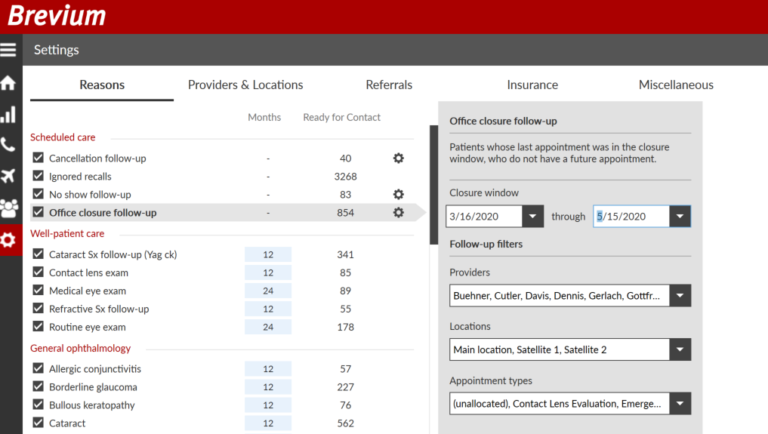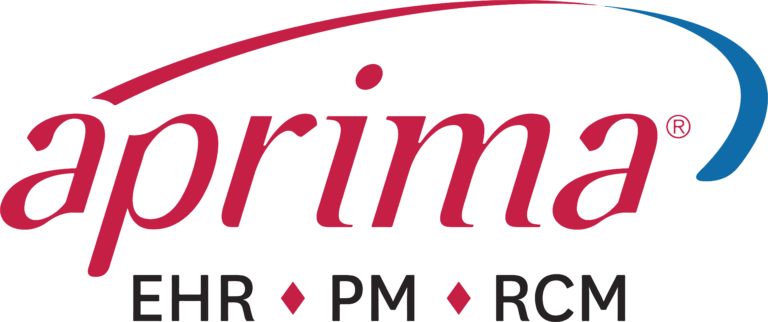The Brevium Blog
Unleashing the Potential of Your Patient Database: Harnessing Patient Reactivation Software
Healthcare practices across the nation use databases and management systems to centralize, store and manage important patient information. With many practices having completely shifted from paper to digital records in recent years, healthcare organizations can now access vast amounts of valuable patient data in an instant. Yet as the healthcare industry becomes increasingly reliant on digital platforms to store patient data, tracking and engaging patients becomes much more difficult without software solutions. This is especially true with patient reactivation—a strategy that re-engageslost to follow-up patients dormant in your medical database to return for routine or needed treatment. Did you know that an estimated 25 percent of each practice’s patient database is overdue for care, but only close to 30 percent of practices deploy effective strategies to win them back? Luckily, patient reactivation software exists to help practices mend the gap, offering tools and solutions that uses your extensive patient data to find lost to follow-up patients, engage them and measure your campaign’s success. This guide will discuss the role of patient reactivation software, why these digital tools are important, key features to look for in a solution, best implementation practices, and how to overcome common challenges—ultimately, helping practices learn how to leverage their patient database to drive organic practice growth and experience stellar returns.
What is Patient Reactivation?
Understanding the importance of patient reactivation software first requires knowing what customer reactivation is and why it’s such a crucial process for providers looking to grow their business. Patient reactivation is the comprehensive process of identifying patients lost or overdue for needed care and employing targeted, strategic outreach to bring them back for treatment. Though often taking a backseat to other patient engagement strategies like reminders and recalls, patient reactivation is extremely important for counteracting inevitable patient loss and maintaining clientele; after all, successful medical businesses not only thrive but rely on retaining and reactivating existing patients. Benefitting your patients and practice alike, effective customer reactivation will ultimately enhance patient health outcomes and keep patients compliant with essential treatment while fueling organic practice growth and generating revenue from a previously untapped source.
The Role of Patient Reactivation Software
Patient reactivation software is a comprehensive tool used by healthcare practices to optimize the patient re-engagement process and get lost to follow-up patients back through the door. While these systems vary greatly from one company to the next, these solutions typically offer features that help practices identify, target and follow-up with patients ready for reactivation.
Why Is Patient Reactivation Software Important?
Despite your practice’s best efforts, there will inevitably be patients that slip through the cracks. Many healthcare professionals understand the importance of customer reactivation for increased practice growth and patient retention, but often don’t have efficient processes in place nor the time and manpower to carry out these plans. Manual reactivation strategies usually dominate these failing campaigns, requiring staff time and effort to identify lost to follow-up patients, segment them, perform outreach and follow-up, analyze results, and consistently document their efforts. Lacking the sustainability required of a reactivation campaign, this is where patient reactivation software fills the gap. Reactivation software provides consistency, reliability and accuracy through automation features and advanced reporting tools that manual processes cannot rival. Here are some benefits of implementing patient reactivation software in your practice:
- Boosts revenue and ROI through efficient processes.
- Increases appointment volume and drives organic growth.
- Advanced reporting tools to provide accurate insight for educated decision-making.
- Automates patient outreach and engagement, alleviating organizational stress.
- Enhances patient compliance through strategic outreach.
- Improves patient satisfaction and overall healthcare experience.
Key Features of Effective Patient Reactivation Software
As you begin shopping for patient reactivation software, keep one thing in mind: Not all reactivation software is created equal. Each solution will have its own set of features that your practice may or may not need depending on your unique goals. Here’s four main features you should look for in a reactivation software:
Segmentation Capabilities: Manual segmentation is often a difficult and tedious process that carries a high risk for staff error. Not only is finding lost to follow-up patients a time-consuming task but segmenting them into groups with similar care needs for personalized reactivation campaigns requires even more effort from your staff. Choosing a software that streamlines this process by identifying and segmenting your lost to follow-up patients for you allows your practice to reactivate efficiently according to provider availability and personalized goals. Brevium, the pioneer and leader in patient reactivation technology, allows its customers to segment based on many different patient identifiers, including billing history, treatment history, insurance carrier, no-shows or cancellations, treatment location, and much more. Further, Brevium has the patented ability to mine the different types of medical database using ICD-10 and CPT codes to identify inactive patients by specific diagnosis, allowing your practice to prioritize high-risk and high-value patients.
Automated Outreach: One of the primary reasons customer reactivation campaigns fail is because practices don’t have the time nor manpower to stay consistent with patient outreach and follow-up. If staff don’t have the time to stay on top of sending out contacts and following up with patients that don’t respond, all of their efforts are in vain, and your lost to follow-up patients will remain lost. Rather than letting complex processes hinder your practice’s growth, patient reactivation software like Brevium can help optimize patient communication efforts—saving your staff time and effort while increasing profitability. After selecting which patients you want to contact, Brevium runs in the background of your daily operations and uses a mix of automated outreach methods to contact patients over time without your staff needing to lift a finger.

Multi-Channel Communication: Multi-channel communication is essential for a successful patient reactivation campaign. Brevium’s 2019 ALOHA study found conclusive evidence that utilizing multiple contact methods significantly improves reactivation rates; in fact, the study found that practices who make four to five contact attempts through multiple channels over an extended time period can increase patient reactivation rates by 81 percent. Multi-channel communication has such a high success rate for one reason: reachability. Not all communication channels are created equal and what may work for one patient might fall short for another. For this reason, Brevium employs a mix of auto calls, postcards, letters, emails, texts, and optional staff calls to ensure the highest reachability and in return, the highest patient conversion rates.
Advanced Reporting Tools: Ensuring you have the most accurate and reliable information to make educated decisions is crucial for your practice’s growth; otherwise, you’re stuck working toward growth in the dark. Running the right reports is often a difficult and time-consuming process for practices opting to do the process manually and without the right technology, practices cannot access the detailed reporting needed to work toward specific goals. With Brevium’s reactivation software, practices no longer need to make important decisions based off assumptions and inaccurate data. This patented technology provides in-depth and accurate reporting that offers immediate insights into the success of your patient engagement and retention efforts. Whether your practice wants to analyze contact attempts, appointments scheduled, conversion rates, revenue generated, and much more, the reports are customizable to your practice—arming you with concrete data to aid practice growth and expansion.

Implementing Reactivation Software in Your Practice
We’ve established that investing in patient reactivation software is more than just an added convenience—it’s an essential asset for practices wanting to drive future growth and sustainability while prioritizing higher quality patient care. However, understanding the need for the software and actively implementing it into existing workflows are two different stories. The following are key strategies practices should adopt before, during and after implementing patient reactivation software to ensure a seamless transition and operational efficiency:
Set Reactivation Goals
Many practices begin customer reactivation campaigns without establishing specific goals other than reactivating as many patients as possible. While that goal is admirable, this reactivation technique of contacting all overdue patients at once is a waste of your software’s potential. Take Brevium for example. Brevium’s unique patient reactivation solutions were purposely created to be customized according to each individual practice’s needs. Using its patented data mining software, Brevium searches your patient database and identifies lost to follow-up patients using specific patient identifiers such as ICD-10 and CPT codes, providers, locations, referrals, billing codes, treatment history, and insurance carrier. Then, based on your practice’s unique goals, the software will engage specific patient types and fill your schedule with the lost to follow-up patients you deem to be of the highest value and highest priority. Ultimately, your understanding of your chosen reactivation software combined with your practice’s established goals will help you know which patients to target first and the metrics to track to define your campaign’s success.

Prepare Your Staff
Even with the most user-friendly and hands-free software, your staff must be provided with the proper training and direction to be successful. Since patient reactivation software typically acts as an extension of your office staff by automating tasks they would have normally done, your team needs to be informed on the goals and objectives of the new campaign and how the reactivation software will go about engaging and bringing back lost to follow-up patients. Further, your staff needs to be aware of what the software sets out to accomplish and what then becomes their responsibility. For example, the software will be sending out thousands of contacts to lost to follow-up patients weekly. Though the responsibility to contact the patients has been removed from their plate, your staff will still have to be prepared to answer the phone and gather the right information when patients call to schedule appointments, ask questions or seek further information. Preparing your staff to handle the results of your patient reactivation campaign through necessary training and guidance will not only lead to increased staff satisfaction, but also improved patient health outcomes and practice efficiency.
The following are a few ways you can set up your staff for successful customer reactivation:
- Train them on the entire reactivation process and how the software works to assist their efforts.
- Prepare them for an increase in phone calls from inactive patients looking to schedule appointments, ask questions or seek further information.
- Provide a script or guideline on how to answer patients’ questions over the phone to avoid confusion or miscommunication. Asking the right questions helps your staff know the reason for the call, what contact they are responding to (reminder, recall or reactivation), if they need to get on the schedule, and who they need to meet with (doctor, PA, etc.).
Gradual Rollout and Monitoring
Introducing a new software into your practice’s established workflow can be a nerve-racking experience. Considering the timeline and process for integration with other practice databases, training staff on the new system, rolling out the software, and seeing results, many practices hesitate to commit despite the unparalleled returns from implementing reactivation technology. However, practices have the option to gradually rollout the software by limiting the initial number of contacts sent to lost to follow-up patients, allowing them to test features and make changes according to real patient data. Based on the success of these efforts, practices can then increase patient contacts to include more diagnoses, providers and locations—ultimately improving the quality of the final product to generate greater returns.
Track Your Success
Once your practice begins to implement patient reactivation software, monitoring the incoming data and evaluating the results of your efforts becomes that much more crucial. Your reactivation data is an essential tool that tells a story of the overall effectiveness of your campaign, providing vital insight into what’s working for your practice and potential areas for improvement. Running the right reports through manual processes or practice management systems is a difficult task, but practices now have patient reactivation software to automate this process. With a software like Brevium, practices gain immediate insight into the success of their customer reactivation efforts through customized, detailed reports. Better yet, these reports are constantly updating to reflect the newest data, ensuring you always have the most accurate information for informed decision-making readily available for your use.
Outside of the more detailed reports, there are seven key metrics your reactivation software should track to provide insight into the overall success of your patient reactivation campaign:
- Contacts sent – number of contacts sent to lost to follow-up patients.
- Outreach channels – communication mediums utilized for patient outreach (staff calls, auto calls, texts, emails, postcards and letters).
- Patient types – patients targeted for reactivation (according to: diagnosis, procedures, billing codes, insurance carrier, treatment history, provider, location, etc).
- Appointments scheduled – total appointments scheduled only by lost to follow-up patients.
- Appointments kept – total appointments kept by lost to follow-up patients that scheduled appointments.
- Patient conversion rate – percentage of patients reactivated compared to contacts sent.
- Revenue generated – total amount of revenue generated as a result of your reactivation efforts.
Overcoming Common Challenges with Brevium’s Patient Reactivation Software
Though it appears straightforward, integrating patient reactivation strategies into an established workflow isn’t always a cakewalk and comes with its own set of challenges that often hinder a practice’s ability to effectively re-engage their patients. Ranging from staffing issues to accessibility, the following are common challenges practices face with customer reactivation and how implementing Brevium’s patented reactivation solutions can bridge the gap to success:
Staff Availability & Training
Patient reactivation campaigns are often as successful as the amount of time and resources practices have or are willing to dedicate toward the process. However, healthcare staffing shortages across the nation are constantly keeping practices from reaching their full potential by limiting the amount of time spent on patient reactivation—a process often pushed to the wayside in favor of other important tasks. Further, practices that do have the staff available to perform customer reactivation don’t always employ the best strategies, often resulting in wasted time, effort and resources. Fortunately, Brevium’s technology was purpose-built to help practices streamline the patient reactivation process, giving practices access to the best tools and strategies for success while relieving organizational stress. As mentioned before, Brevium’s software runs in the background of daily operations and performs automated patient outreach and follow-up so your staff doesn’t have to. The software also offers a live caller program that allows practices to manually contact patients as much or as little as they wish. Brevium is with its customers through every step of the integration process, offering free support and training before, during and after going live that will ensure your practice’s success and profitability.
Inaccurate Patient Data
One of the biggest reasons patient reactivation campaigns fail is because practices don’t have the right data to effectively identify and engage their lost to follow-up patients. Practices may have inaccurate data for many reasons:
- Switched practice management systems (PM) and no longer have access to important patient identifiers such as disease profile, treatment and appointment history, billing history, and more.
- Patient information is no longer correct and needs updating.
- Staff error inputting information.
Luckily, Brevium is a multi-faceted solution to help practices overcome inaccurate data and efficiently get patients back through the door. Brevium understands that changing PM is a common occurrence in the healthcare industry and that losing patient data hinders many different processes important to patient retention and organizational growth. Because of this common experience, Brevium created the Stitch to help practices recover priceless patient data by merging or “stitching” the old PM with the new, creating one seamless file of patient history. Through this stitch, Brevium’s patented data mining software combs through both management systems to match patients, providers and locations across systems—giving practices the necessary patient insights to start patient reactivation. Without the Stitch capabilities, it would take years and extensive resources to recover complete patient files, if at all.
Brevium also combats inaccurate patient data by implementing multi-channel outreach—a proven strategy to increase patient reactivation success. Many practices only use one or two communication channels for reaching out to lost to follow-up patients and wonder why they don’t find the success they’re looking for. Not all communication channels are created equal, with Brevium finding that staff calls, auto calls and postcards have a higher reachability than email and text messaging. However, Brevium found in its ALOHA study that practices could reach 95 percent of lost to follow-up patients when employing at least three different outreach methods in their communication strategy. Practicing what they preach, Brevium uses five different automated outreach channels (auto calls, postcards, letters, emails and texts) and optional live staff calls to engage patients through different mediums—ultimately ensuring that inaccurate or incomplete data doesn’t hinder practice growth.
Database Customizations
Many practices have customizations in their practice management systems that not all software can work with or read. From unique guidelines to marking and notating patients to customized service codes, practices must ensure the software they integrate into their workflow can be personalized to meet their individual needs. Let’s use the dermatology specialty as an example. While all practices use the same ICD-10 and CPT codes to notate medical conditions, each practice has their own way of tracking aesthetic procedures—meaning one practice’s codes for marking patients will likely not match the next. However, dermatology practices looking to focus more on reactivating cosmetic patient types can rely on Brevium to adapt and find patients according to their unique, established coding system by working with the Brevium team to build out those customizations within the software.
Schedule a Demo with Brevium
The demand for patient reactivation software has increased in recent years as healthcare practices learn to navigate a post-COVID-19 industry. Not only did the pandemic exacerbate existing patient retention issues, but practices are also starting to realize the value their lost to follow-up patients hold and how leaving these patients behind only results in missed opportunities and diminished engagement. Now that patients are able to return for treatment, practices are looking to patient reactivation software as a solution to re-engage their lost patients without disrupting practice workflows. Choosing a software vendor can be a daunting process; luckily, there is a clear difference between industry leaders like Brevium over other solutions that either don’t specialize in patient reactivation or have more limited capabilities. Though it’s true Brevium also does patient reminders and recalls, the software’s true niche is patient reactivation. With the ability to seamlessly integrate with most practice management systems, Brevium is the ultimate solution for practices looking to enhance patient health outcomes, increase appointment volume and boost revenue through patient reactivation.
Schedule a demo with Brevium today to learn how their patented patient reactivation solutions can address your practice’s unique goals and make your business more profitable.














